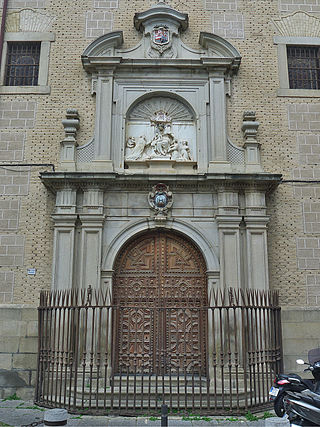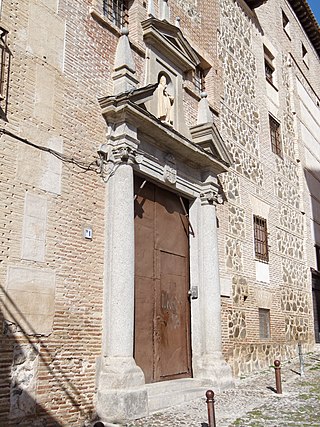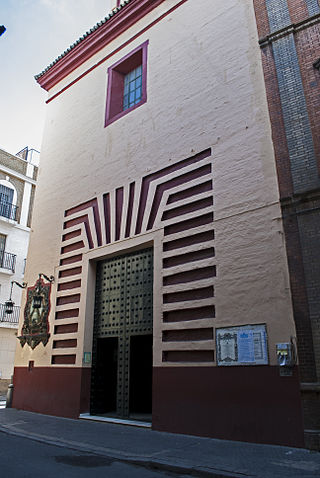
Luis de Vega was a 16th-century Spanish architect appointed royal architect of Charles I.

The Colegio de Doncellas Nobles is a former girls' school in Toledo. It was founded in 1551 by the archbishop of Toledo and cardinal Juan Martínez Silíceo. The project, which had as its patron the king Philip II as well as the archbishop, had as its object the education of young women to be good mothers. Some came from humble families and others from noble families from all over Europe. They were expected to be of "clean blood". Funding was provided for the dowries of former pupils.

The now defunct Convento de San Felipe el Real was a former Madrilenian convent of Calced Augustinian monks, located at the beginning of Calle Mayor in Madrid, next to the Puerta del Sol. Built between 16th and 17th centuries, was rise on a large pedestal, was part of it a famous talking shop of the city. One of its famous guests was Friar Luis de León. It was opposite the Palacio de Oñate.

The Convento de Premonstratenses de San Norberto, also known as Convento de Mostenses or Convento de San Norberto, named after the founder of the Premonstratensian Order, is a religious building that disappeared. It was located on the ground of the current Plaza de Los Mostenses, next to the Gran Vía of Madrid (Spain). It was founded in 1611 by the community of the Fathers Canons Premonstratensians with the permission of Cardinal Archbishop of Toledo Bernardo de Rojas and financed by a benefactor, the Count of Miranda, Juan of Zúñiga, the then president of the Council of Castile. Today the site of the convent is occupied by a market built in the 19th century, known as Mercado de Los Mostenses.

The Instituto de Enseñanza Secundaria San Isidro is a co-educational day school for pupils from 12 to 18 years of age. It is located in the historical Calle de Toledo in Madrid, Spain.

The Convent of the Calced Augustinians is an Augustinian convent located in Toledo, Spain. The word calzadas translates to "calced" in English, referring to the fact that the community wore shoes, rather than going barefoot as other (stricter) religious orders did.

The Convento de San Clemente is a Renaissance convent located in the city of Toledo, in Castile-La Mancha, Spain. It was founded in the 13th century during the reign of Alfonso X of Castile the Wise. Inside the building there are a Roman cistern, Mudéjar architecture, remains of the Palacio de los Cervatos and many decorative elements.

The Agustinas Ermitañas Convento Santa Úrsula is an Augustinian convent located in the city of Toledo, in Castile-La Mancha, Spain. It was founded in 1259.

The Colegio de Nuestra Señora de los Infantes is a school in the city of Toledo. It was founded in the 16th century by Juan Martínez Silíceo, Archbishop of Toledo and later a cardinal, and was intended to provide a specialist musical education for the cathedral's young singers.

The Covento de San Gil currently houses the Cortes of Castilla-La Mancha. It was a convent and currently a government building located in the city of Toledo dating to the 17th century. The Dicalced Franciscans, or gilitos, arrived in this city in the middle of the 16th century, and established it in 1557 in the vicinity of the Ermita de la Virgen de la Rosa. Later, in the early 17th century, two brothers, Francisco and Juan de Herrera, donated to the friars 16,000 ducats for the construction of the new convent.

The Convento de la Madre de Dios is a Dominican convent located in the city of Toledo. It was founded at the end of the 15th century as a nunnery by Leonor and María de Silva, daughters of the Count of Cifuentes. It was a cloistered monastery, a Guardia Civil barracks, and finally a university campus after its acquisition by the University of Castilla-La Mancha to expand the facilities of the Faculty of Juridical and Social Sciences.

The Convento de las Carmelitas Descalzas de San José of Toledo is a monastic building dating from the second half of the 16th century.

The Convento de San Antonio de Padua is a Franciscan convent located in Toledo, Castile-La Mancha, Spain. Dedicated to St Anthony of Padua, the institution was created in 1525 in the former palace of the advisor comunero Don Fernando de Ávalos, confiscated by order of Charles V, Holy Roman Emperor because its owner was a comunero. The entrance is Gothic-Mudéjar of the 15th century.

The Convento de Santa Clara la Real is a convent of the Poor Clares located in the city of Toledo, Castile-La Mancha, Spain. The present convent was founded in the middle of the 14th century by Toledan noblewoman María Meléndez, and is located near other monasteries of note, such as the monastery of Santo Domingo el Real and the Convent of Capuchins of Toledo.

The Convento de Santa Isabel de los Reyes is a convent located in the city of Toledo, in Castile-La Mancha, Spain. The current convent, founded in 1477 by Doña María Suárez de Toledo, known as "Sor María la Pobre", has its origins in two different palaces, both Mudéjar from the 14th century and the church of San Antolín.

The Convento de la Purísima Concepción, also called Convento de Capuchinas, is a convent located in the city of Toledo, in Castile-La Mancha, Spain.
The Plaza de San Justo is a square located in the city of Toledo, in Castile-La Mancha, Spain. In the upper part of the city, halfway between the Alcázar and the Cathedral there is a square named after the Church of San Justo y Pastor. Of the same church and in that same square it says the legend of "The Christ of the Cutlery". There a sign where it read the legend where events are supposed to happen, or not.

St. Buenaventura's Church is situated in the calle Carlos Cañal in the Casco Antiguo of Seville, Andalusia, Spain. It was the church of the Franciscan College of San Buenaventura that was destroyed in the 19th century.



















